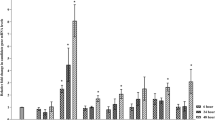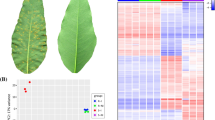Abstract
In this study, we systematically examined the expression patterns of pathogenesis-related genes in model plant Arabidopsis thaliana after Alternaria brassicae inoculation using reverse transcription polymerase chain reaction(RT-PCR). Based on the results, none of the PR-1 and PR-2 like genes were induced significantly in the unwounded local or distal leaves upon A. brassicae challenge. However, only At2g14580 of the PR-1like gene showed a significant expression in wounded leave after Alternaria challenge but not in control; confirming its expression in response to A. brassicae was aided by the wounding. Among PR-3 like genes, At2g43590 showed local early expression and other PR-3 like genes showed significant distal expression after A. brassicae infection only in unwounded but not in wounded leaf samples. Although all the three PR-12 like genes were induced in local tissues, At2g26020 was the only gene showed significant induction locally as well as systemically after pathogen infection in the both with and without wounding experiments. Therefore, among the PR-1, PR-2, PR-3 and PR-12 like genes studied, At2g26020 can be the most promising candidate for the further line of research, viz, molecular characterization of its promoter to develop pathogen-inducible promoter in response to Alternaria and to develop fungus-resistant transgenics in Brassica juncea.





Similar content being viewed by others
References
Ali S, Mir ZA, Tyagi A, Mehari H, Meena RP, Bhat JA, Yadav P, Papalou P, Rawat S, Grover A (2017a) Overexpression of NPR1 in Brassica juncea Confers Broad Spectrum Resistance to Fungal Pathogens. Front Plant Sci 8:1693. https://doi.org/10.3389/fpls.2017.01693
Ali S, Mir ZA, Bhat JA et al (2017b) Isolation and characterization of systemic acquired resistance marker gene PR1 and its promoter from Brassica juncea. 3 Biotech 8:10. https://doi.org/10.1007/s13205-017-1027-8
Ali S, Chandrashekar N, Rawat S, Nayanakantha NMC, Mir ZA, Manoharan A, Sultana M, Grover A (2017c) Isolation and molecular characterization of pathogenesis related PR2 gene and its promoter from Brassica juncea. Biol Plant 61(4):763–773. https://doi.org/10.1007/s10535-017-0726-7
Ali S, Mir ZA, Tyagi A et al (2017d) Identifcation and comparative analysis of Brassica juncea pathogenesisrelated genes in response to hormonal, bioticand abiotic stresses. Acta Physiol Plant 39:268. https://doi.org/10.1007/s11738-017-2565-8
Cammue BP, Thevissen K, Hendriks M, Eggermont K, Goderis I, Proost P, Van Damme J, Osborn RW, Guerbette F, Kader JC (1995) A potent antimicrobial protein from onion seeds showing sequence homology to plant lipid transfer proteins. Plant Physiol 109:445–455
Chandrashekar N, Ali S, Rawat S, Grover A (2015) Gene expression profiling of Arabidopsis thaliana chitinase genes in response to Alternaria brassicae challenge. Indian Phytopath 68(1):106–111
Delaney TP (1997) Genetic dissection of acquired resistance to disease. Plant Physiol 113:5–12
Durrant WE, Dong X (2004) Systemic acquired resistance. Annu Rev of Phytopath 42:185–209
Grover A (2012) Plant chitinases: genetic diversity and physiological roles. Crit Rev Plant Sci 31:57–73
Grover A, Gowthaman R (2003) Strategies for development of fungus-resistant transgenic plants. Curr Sci 84:330–340
Grover A, Pental D (2003) Breeding objectives and requirements for producing transgenics for major field crops of India. Curr Sci 84:310–320
Jayaraj J, Punja ZK (2007) Combined expression of chitinase and lipid transfer protein genesin transgenic carrot plants enhances resistance to foliar fungal pathogens. Plant Cell Rep 26:1539–1546
Katiyar RK, Chopra VL (1990) Somaclonally induced earliness in a Brassica juncea germplasm accession with field resistance to important diseases. Plant Breed 104:262–264
Mehrotra RS, Aggarwal A (2003) Plant pathology: Alteration in plant physiological function due to plant-pathogen interation, 2nd edn. Tata Mcgraw-Hill education, New Delhi, Print
Mishra A, Pandey D, Goel A, Kumar A (2010) Molecular cloning and in silico analysis of functional homologues of hypersensitive response gene(s) induced during pathogenesis of Alternaria Blight in two genotypes of Brassica. J Prot Bioinf 3:244–248
Mukherjee AK, Lev S, Gepstein S, Horwitz BA (2009) A compatible interaction of Alternaria brassicicola with Arabidopsis thaliana ecotype DiG: evidence for a specific transcriptional signature. BMC Plant Biol 9:31
Narusaka M, Minami T, Iwabuchi C, Hamasaki T, Takasaki S, Kawamura K, Narusaka Y (2015) Yeast cell wall extract induces disease resistance against bacterial and fungal pathogens in Arabidopsis thaliana and Brassica crop. PLoS One 10(1):e0115864
Nayanakantha NMC, Rawat S, Ali S, Grover AA (2016) Differential expression of defense-related genes in Sinapis alba and Brassica juncea upon the infection of Alternaria brassicae. Trop Agri Res 27 (2):123–136
Pieterse CMJ, Leon-Reyes A, Van Der Ent S, Van Wees SCM (2009) Networking by small-molecule hormones in plant immunity. Nat Chem Biol 5:308–316
Rawat S, Ali S, Nayankantha NNC, Chandrashekar N, Mittra B, Grover A (2017) Isolation and expression analysis of defensin gene and its promoter from Brassica juncea. J Plant Dis Prot 124(6):591–600. https://doi.org/10.1007/s41348-017-0103-y
Shah J, Zeier J (2013) Long-distance communication and signal amplification in systemic acquired resistance. Plant Sci 4:1–10
Swegle M, Kramer KJ, Muthukrishnan S (1992) Properties of barley seed Chitinases and release of embryo associated isoforms during early stages of imbibitions. Plant Physiol 99:1009–1014
Thakur R, Kolte SJ (1985) Radish root extract agar, a suitable medium for the growth and sporulation of Alternaria brassicae. Cruciferae News Lett 10:117–118
Thomma BPHJ., Eggermont K, Broekaert WF, Cammue BPA (2000) Disease development of several fungi on Arabidopsis can be reduced by treatment with methyl jasmonate. Plant Physiol Biochem 38:421–427
Thomma BPHJ., Cammue BPA, Thevissen K (2002) Plant defensins. Planta 216:193–202
Van Loon LC, Van Strien EA (1999) The families of pathogenesis-related proteins, their activities, and comparative analysis of PR-1 type proteins. Physiol Mol Plant Pathol 55:85–97
Vishwanath, Kolte SJ, Singh MP, Awasthi RP: Induction of resistance in mustard (Brassica juncea) against Alternaria black spot with an avirulent Alternaria brassicae isolate-D. Eur J Plant Pathol 105:217–220
Acknowledgements
We are grateful to the project director, National Research Centre on Plant Biotechnology Pusa Campus New Delhi for providing all the necessary facilities for this work and also we are thankful to the head of the national phytotron facility for having provided space for plant growth, development, and maintenance.
Author information
Authors and Affiliations
Contributions
NC planned and conducted experimental work, SA helped in drafting the manuscript, and AG has designed the work and approved the final manuscript.
Corresponding author
Ethics declarations
Conflict of interest
The authors declare that they have no conflict of interest.
Rights and permissions
About this article
Cite this article
Chandrashekar, N., Ali, S. & Grover, A. Exploring expression patterns of PR-1, PR-2, PR-3, and PR-12 like genes in Arabidopsis thaliana upon Alternaria brassicae inoculation. 3 Biotech 8, 230 (2018). https://doi.org/10.1007/s13205-018-1259-2
Received:
Accepted:
Published:
DOI: https://doi.org/10.1007/s13205-018-1259-2




